Medicine Hat Paint Horse’s Eyes Saved by Special Laser Treatment For Humans
Penn Vet Extra by: Louisa Shepard
In the first collaboration of its kind between Penn Vet and Penn Med, clinicians used a laser treatment for humans to treat cancerous tumors in the delicate area around both eyes of a horse.
Anita is a special type of Paint horse known as Medicine Hat, prized in many Native American cultures. Distinguished by their markings, Medicine Hats are mostly white with a brown “war bonnet” over the ears, a “shield” of brown on the chest, and blue eyes. Unfortunately, Anita’s light pigmentation increased her risk for developing squamous cell carcinoma, a tumor more likely to develop in white horses due to UV light exposure.
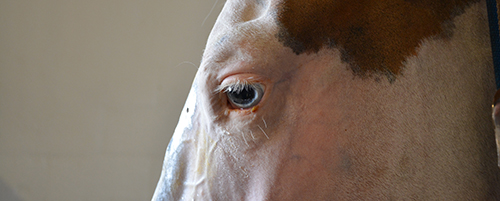
The traditional treatment for large areas of eyelid squamous cell carcinoma is a surgical procedure to remove the masses, often transplanting skin from the face to close the wounds and regain eyelid function, according to Dr. Catherine Nunnery, Large Animal Ophthalmologist at New Bolton Center. In Anita’s case, that approach was impossible because the cancerous masses were too large, and using skin from her face was too risky, since the nearby skin was likely to also contain cancer cells.
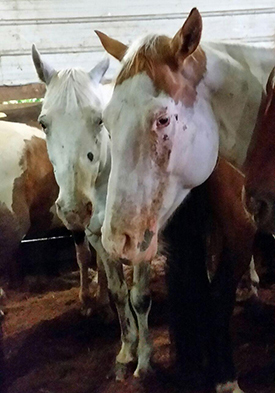 Usually the treatment in Anita’s case might require removal of her eyes, an enucleation, Nunnery said. However, 10-year-old Anita is a rescue horse, saved from a kill pen by Omega Horse Rescue. Removal of her eyes would make finding her a home nearly impossible. Saving her eyes, on the other hand, might just save her life.
Usually the treatment in Anita’s case might require removal of her eyes, an enucleation, Nunnery said. However, 10-year-old Anita is a rescue horse, saved from a kill pen by Omega Horse Rescue. Removal of her eyes would make finding her a home nearly impossible. Saving her eyes, on the other hand, might just save her life.
“We were going to do whatever we could to try to help this horse,” said Kelly Smith, founder and director of Omega, a non-profit in Airville, PA. “She has been absolutely wonderful in every way.”
Nunnery knew the University of Missouri College of Veterinary Medicine pioneered the use of Photodynamic Therapy (PDT), a laser treatment to kill cancer cells on the margins of tumors, on horses. Why not try that at Penn Vet?
Penn Vet-Penn Med Collaboration
Enter Dr. Keith Cengel, Associate Professor of Radiation Oncology and the Director of the Photodynamic Therapy Program at the Perelman School of Medicine. When Nunnery asked to borrow the equipment, he not only said yes, but also said he would come to perform the procedure, along with Carmen Rodriguez, a laser specialist.
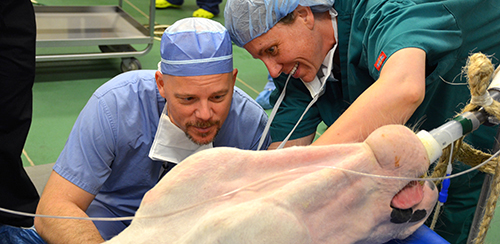
“I am pleased that we are able and allowed to do it because this horse is in bad shape and we can fix it. How cool is that?” Cengel said while preparing for the surgery at New Bolton Center. “Besides, my kids will think I’m a hero.”
Cengel, who has already impressed his kids by working with astronauts, has collaborated with Penn Vet before, but on a much smaller scale. The PDT Team has treated cats, dogs, and birds, working with Dr. Lillian Duda, an Adjunct Associate Professor of Radiation Oncology at Penn Vet’s Ryan Hospital. Anita is the largest creature the team has ever treated.
PDT is a treatment that uses a drug, called a photosensitizer or photosensitizing agent, and a particular type of light, most often a laser. When photosensitizers are exposed to a specific wavelength of light, they produce a form of oxygen that kills nearby cells.
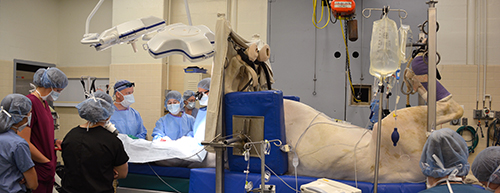
The New Bolton Center pharmacy and ophthalmology teams worked together to procure the necessary drug, and Cengel and Rodriguez provided the equipment and the know-how.
Smith met with the team before the June 19 surgery. “I felt comfortable that what we were doing was the best thing to give Anita a fighting chance,” she said.
A Long Surgery
First, Nunnery and Dr. Nicole Scherrer, New Bolton Center Ophthalmology Resident, performed the nearly four-hour surgery to carefully remove a large part of each tumor from the eyelid. “We only take out what we could see of the tumor,” Nunnery said. “There were cancer cells remaining in the tumor bed.”
The photosensitizer was then injected to treat the remaining tumor cells. Cengel and Rodriguez worked together to use the laser, first by fashioning a mount to hold the fiberoptic that delivers the laser beam, which made a red circle of light over the eye, for 15 minutes. The chemical in the solution reacts to that specific wavelength of light to kill the tumor cells.
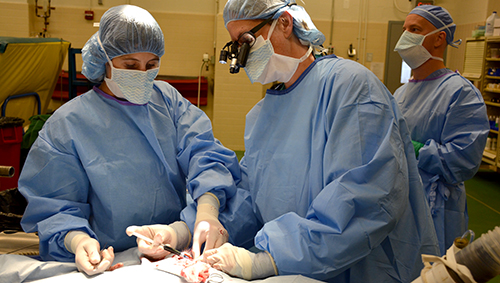
“When done correctly at the right dose, it won’t kill the collagen, so the substance and structure of the tissue won’t be fried,” Cengel said. “This will create much more pure oxidized damage to the cells, so when the tissue heals it is more normal and more functional.” Normal structure and function of the eyelids is vital for ocular health and comfort.
The drug and the light penetrate only a fraction of an inch into the tissue. “It is self-limiting,” Cengel said. “The drug, the light, and oxygen are required, and the light has a limited depth of penetration.”
The procedure does not kill just the cancer cells. “The drug may have some preference for cancer cells, but that is not proven,” he said. “The light is not preferential.”
The chemical will react where it is injected. “I just make sure the light covers the whole area I want to treat,” he said.
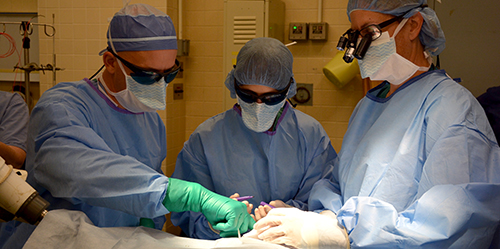
The beam of light does not burn, Rodriguez said. It is a photochemical reaction with the drug injected under the skin. So even though people in the room wear dark glasses as a universal eye safety precaution, this light is at a low dose that doesn’t hurt skin. “To prove it, I’ll put my hand under the treatment beam,” she said, running her hand through the red light.
Anita was then moved onto her other side and the procedure was repeated. The area on the right eye – 40 mm by 20 mm – was much larger than the one on the left—10 mm by 5 mm.
“This is much larger than usual, compared to what they do at Missouri,” Nunnery said during the procedure. “We are pushing the limits, but why not try?”
Skin is Ideal
Although Cengel, Rodriguez, and the other members of the PDT team work on many areas of the human body – including around the nose and eyes, as well as the chest, esophagus, and peritoneal cavity – skin is ideal for this therapy.
“Most of the time we end up treating in a protocol where standard approaches won’t work,” Cengel said.
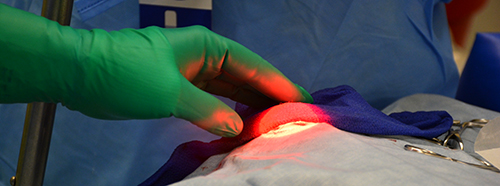
He also said he believes that human medicine can learn from equine medicine. For example, the skin of a horse is very similar to the skin of a human, Cengel said. “Half a centimeter of light penetration is similar to what we would use for a human,” he said.
“Life span and other characteristics of horses are similar to cancer in humans in many ways. We have a lot of our DNA in common with horses. A lot of diseases are very similar,” he continued.
“They have needs to be treated just like humans, and we can learn a tremendous amount from taking care of them,” he said. “It helps animals, and helps humans.”
This collaborative effort is one of many between Penn Vet and Penn Med that highlights the importance of One Health, the concept that human, animal, and environmental health are inextricably linked.
Complications
The surgery went well. Anita was discharged ten days later to recuperate at Nicky Manfredi’s farm, just behind New Bolton Center.
Anita’s eyes fully healed from the squamous cell carcinoma, with minimal scarring. The left eye responded particularly well and “looks great,” Nunnery said.
The tumor on the right eye was much larger, and more complicated. Biopsy results after surgery showed that the right eye had not only squamous cell carcinoma cells, but also sarcoid cells.
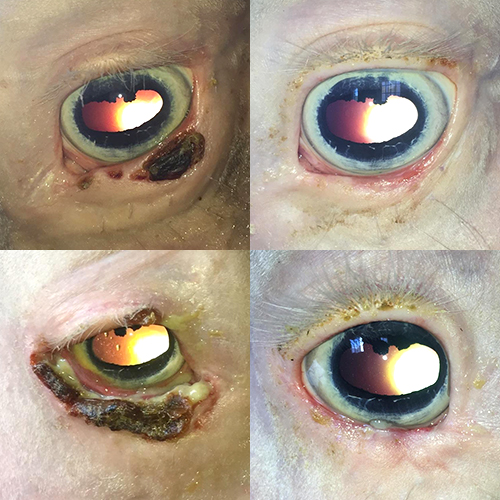 In late August, the area around the right eye showed some swelling, which proved to have sarcoid cancer cells.
In late August, the area around the right eye showed some swelling, which proved to have sarcoid cancer cells.
“PDT seems to be a very good option for squamous cell carcinoma,” Nunnery said. “Early studies out of Missouri show sarcoid in horses is not as responsive to PDT, and is subject to recurrence.”
The best treatment for sarcoid is chemotherapy. Anita started that treatment in September, staying nearby at Manfredi’s farm. The drug is the same used in human medicine, injected into the tumor four to six times, at intervals of two to three weeks.
“It is a small sarcoid, and we are very hopeful chemotherapy will cure the recurrent tumor,” Nunnery said. “Anita is a fighter.”
To prevent these cancers in the future, Anita has to wear a mask to protect her eyes from the sun every time she goes outside.
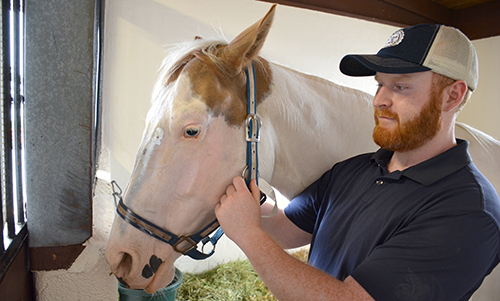
Smith said Anita – a name chosen because of its meaning, grace – may become the “spokeshorse” for Omega.
“The day I saw her in the kill pen, she had given up,” Smith said, explaining that Anita had been sold, weighed, and tagged for slaughter before she was rescued. “You can’t help but feel a lot of sympathy and compassion.
“We try to give every horse that gets on our trailer a good ending,” she said. “In Anita, I see such a willing patient, trying to get well. It speaks volumes about the animal she is inside.”
More Laser Treatments in the Future?
With the success of the laser treatment on the squamous cell carcinoma on Anita’s eyes, will New Bolton Center and Penn Med collaborate to treat horses together again? Nunnery hopes it will be possible.
“We can do the surgery and inject the photosensitizer, but we don’t have a light source to activate the drug. For this procedure to be successful, it will have to be a Penn Vet-Penn Med team effort,” she said, adding that her goal is someday to have the equipment on site at New Bolton Center for future patients. “This is a first step.”










